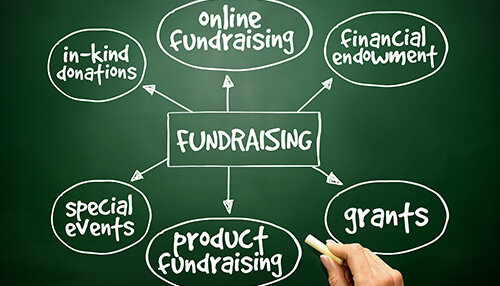Donations are the life-giving blood of any nonprofit organization. Thus, conducting fundraising activities to gather donations is crucial to help you fund your organization’s missions, develop educational programs, pay overhead costs, and make the necessary improvements that will benefit donors and beneficiaries of your organization. However, the world of fundraising can sometimes seem confusing, especially for newbies. But don’t worry! This article shares everything you need to know about fundraising and how to run your first successful fundraising campaign.
Fundraising: What Exactly Is It?
Fundraising is the process of collecting voluntary contributions and financial support. It’s a necessary process for most nonprofits to bring in the needed money and revenue for their organization’s missions.
That said, while the main objective of a fundraising event is to ask for donations and raise money, it also comes with several benefits, including building awareness, establishing relationships, attracting new donors, and bringing in foundation support.
While nonprofit organizations can plan and host their own fundraising campaigns, they may also employ a fundraiser or fundraising firm like Adrenaline Fundraising to develop, design, and promote customized programs.
How to Start And Plan A Fundraising Campaign
1. Set SMART Goals
Every successful fundraising campaign starts with a clear vision and set of goals. You need to determine the ‘why’ of your campaign and understand your goals.
When setting fundraising goals, you should always follow the SMART model. This means you need these five qualities for your goal:
1. Specific: Your goals should be well-defined and clear.
2. Measurable: It should have specific criteria to measure against your progress towards accomplishing your fundraising goal.
3. Achievable: Your fundraising goals should be realistic and attainable.
4. Relevant: It should be relevant to your organization’s purpose and goal.
5. Time-Bound: Your goal should have a clearly defined timeline to create a sense of urgency.
By setting SMART goals, you’ll have a better idea of how to go about fundraising as you have a clear vision and set of goals to guide you. For instance, if you’re running an animal shelter, a SMART goal would be to raise USD$10,000 in two weeks to buy animal food and medical supplies.
2. Understand Your Donors
As the primary part of any campaign, having a better understanding of your donors and sponsors and what matters to them allows you to create meaningful connections.
In general, you want to create donor personas or profiles to visualize the typical supporters of your organization. A donor persona is a virtual representation of the average donor that incorporates their demographic information, passions, goals, and preferred communication style.
You also want to segment your donors based on specific attributes, such as interests and demographics. For instance, you can segment donors according to their gift size, frequency of giving, how and when they started donating, and more. Segmenting your donors allows you to personalize your offerings and messaging for higher engagement.
3. Identify The Beneficiary
If you’re setting a fundraising campaign for a nonprofit organization, you want to have a full understanding of your beneficiary. As a donor, would you rather give to a faceless organization or an Animal Rescue Shelter known in your local community?
Most donors are inspired to give to real organizations with compelling stories. By sharing the beneficiaries’ stories and adding a few videos or pictures, you can bring to life the work that your organization is doing. When soliciting donors, don’t just tell them the number of beneficiaries positively impacted by their donations. You want to show them proof that they helped change someone’s life.
4. Choose A Type Of Fundraising Campaign
Did you know that there are many different types of fundraisers out there? And choosing one can be confusing. In general, you want to consider your budgets, goals, and resources to help you make a decision.
That said, here are the most popular options for your fundraising campaign:
1. Capital Campaigns
A capital campaign is for a specific project or cause focused on soliciting major gifts and raising a large amount of money within a specified time. Generally, capital campaigns are used for large projects such as purchasing a new building or renovations.
2. Awareness Campaigns
This type of campaign aims to educate people and raise public awareness about a nonprofit organization’s issue or cause. The main focus is on educating the public about the organization’s cause in hopes of raising support and donations for it.
3. Text-To-Give Campaigns
A text-to-give campaign is a relatively new fundraising type. It allows people to donate money to your organization from their phones via a text message. Its simplicity appeals to younger donors and helps increase its popularity.
4. Online Fundraising Campaigns
These are fundraising campaigns that occur entirely on the internet. It uses digital channels such as email and social media to spread an organization’s message and ask for support from its virtual audience.
5. Event Fundraising
Fundraising through events is one of the most common types of campaigns in the nonprofit community. Whether you’re hosting a gala dinner, walkathon, field day, concert, or exhibits, events can help donors and participants to interact with one another and learn more about your organization and its mission.
6. Crowdfunding
Crowdfunding has become a popular and common type of fundraising recently, thanks to social media. It’s all about appealing to many individuals to give small donations.
In general, crowdfunding on social media is more commonly used by individuals who need to raise funds for personal use, for instance, to pay for medical expenses or recover from natural disasters. That said, it’s also used by nonprofits and corporate organizations alike.
7. Peer-To-Peer Fundraising
Peer-to-peer fundraising uses your donor’s existing networks. We encourage your existing supporters to reach out to their peers and ask them to donate. With this type of fundraising, every individual supporter sets up their personal fundraising page where they can accept donations. The donations they collect are then turned over to the nonprofit organization.
5. Choose A Fundraising Platform
Regardless of the type of fundraising campaign you’re planning, you’ll need to use technology to help streamline processes, such as accepting donations, processing payments, and managing your donors and sponsors.
If you choose to organize a fundraising event, you’ll also need a platform to register your event attendees. Whether you have an in-person or virtual event, it’s helpful to use a platform to check in guests and accurately track attendance. For more specific needs, you may also need to look into platforms that enable crowdfunding, peer-to-peer fundraising, text-to-give donations, and more.
Regardless of what platform you invest in, always choose something that has built-in donor management features or can seamlessly integrate with your current donor management software. This way, new data about your donors will automatically be imported and effectively managed, making reporting, accounting, and future campaigns much easier to understand and manage.
6. Build Your Promotional Materials
A successful campaign should have a compelling message that encourages your donors and audience to act. Thus, you want to focus on a single story about a program you need to create or someone in need. Tell your community and audience how their donations can make a difference in someone’s life and what could happen if you don’t reach your goals.
If your fundraising campaign uses different marketing channels, ensure they all tell the same story to avoid confusion. Also, seeing the same message in various places can make your campaign more memorable so that you can stay on top of your donor’s and audience’s minds.
That said, it’s vital to customize your message for each marketing channel. For instance, a social media post can be less formal and shorter, while an email can be formal and more detailed.
In addition to creating a compelling story, you also want to include quality images in your promotional materials. A picture is worth a thousand words—and using the right one can help your donors visualize your fundraising goals and missions.
Make sure to create posters, graphics, and shareable social images. Don’t forget videos or even fun animations to help inspire people to act.
7. Identify Your Marketing Channels and Promote
A compelling story and visuals are utterly useless if no one knows about them. This is where marketing and promotion come in. While traditional marketing is still feasible for campaigns, digital channels are the more modern approach to reach your donors faster and ensure high engagement.
Here are some of the best digital channels you can use to promote your fundraising campaign:
- Website and landing pages
- Social media
- Paid Ads
- Digital PR
Once you’ve identified your marketing channels, you need to learn how to properly promote your campaign in each channel and start promoting. It’s best to use as many of the above channels as possible to help spread the word about your campaign.
Takeaway
The process of raising funds can be quite challenging and daunting for beginners. It can be scary to dip your toes into the fundraising world, but everyone starts feeling awkward and confused. With that, this article has provided you with the basic know-how to be a great fundraiser to help you be better equipped to navigate the world and achieve success on your first fundraising campaign.



